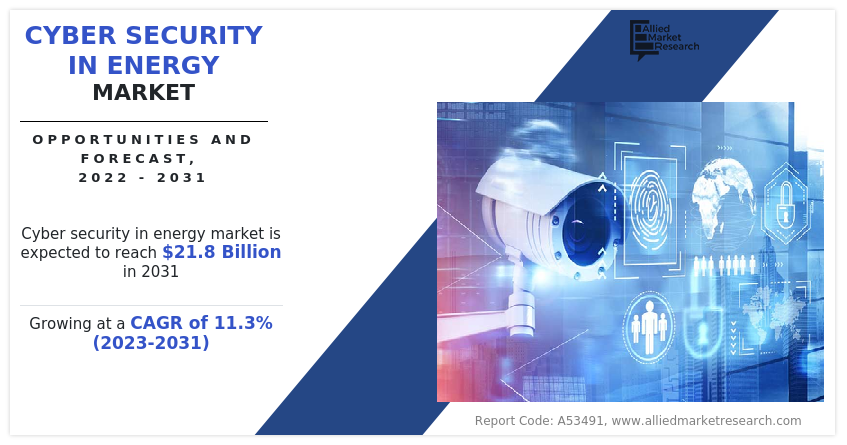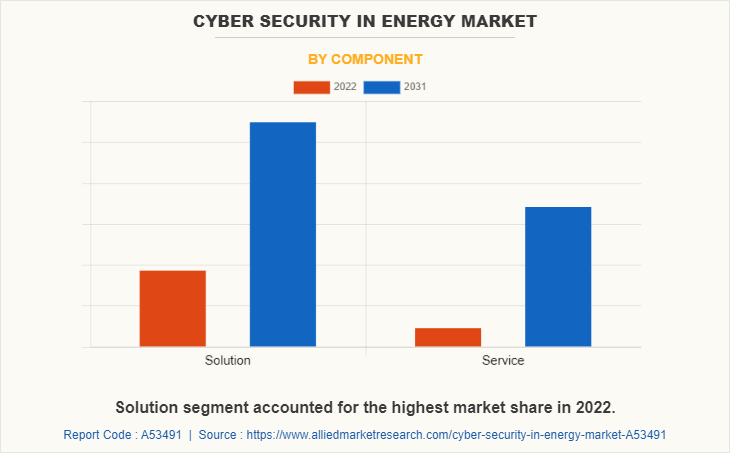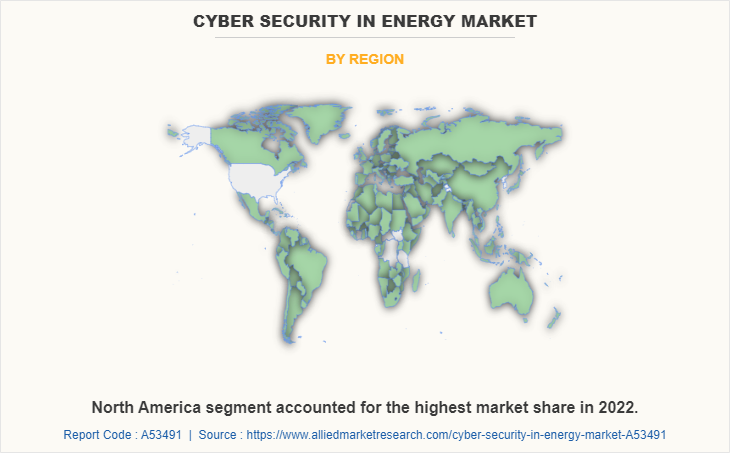Cyber Security in Energy Market Overview
The global cyber security in energy market was valued at USD 8.6 billion in 2022 and is projected to reach USD 21.8 billion by 2031, growing at a CAGR of 11.3% from 2023 to 2031.
The market has grown as a result of shifting trends, expectations, and behavior in energy market owing to the numerous advantages provided by the digitalization of energy & utility services. Furthermore, the rise in need and requirement to keep information, data, and devices secure in the energy sector fuels the market. In addition, surge in risks of cyber-attacks on energy industry for execution of mass operations boosts cyber security in energy market growth. However, high acquisition costs and complexities of cyber security hinder the growth of the market.

On the contrary, technological advancements in cyber security in energy, such as inclusion of artificial intelligence (AI) and automations, are expected to fuel the growth of the market in upcoming years. Moreover, the rise in adoption of digital practices for various operations in energy sector is expected to provide lucrative opportunities for the cyber security in energy market to grow in upcoming years.
Cybersecurity incorporates a comprehensive range of tools, practices, and techniques interrelated closely to operational and information technology security. This method uses protective and responsive methods to defend networks and information from being attacked and compromised. Moreover, cybersecurity utilizes legacy malware protection, web filtering, and advanced threat defense to defend users from internet-borne threats, and to help enterprises enforce internet policy compliance. various cybersecurity solutions and services are used to provide security services to prevent threats and improve the overall organizational effectiveness.
The report focuses on growth prospects, restraints, and opportunities in the cyber security in energy market. The study provides Porter’s five forces analysis to understand the impact of several factors, such as bargaining power of suppliers; competitive intensity of competitors; threat of new entrants; threat of substitutes; and bargaining power of buyers on the cyber security in energy market outlook.
Segment Review
The cyber security in energy market is segmented on the basis of component, deployment model, enterprise size, end user, and region. Depending on component, the market is bifurcated into solution and service. By deployment model, the market is fragmented into cloud and on-premises. By enterprise size, it is segregated into large enterprises and SMEs. As per end user, it is classified into industrial, commercial, and residential. Region wise, it is analyzed across North America, Europe, Asia-Pacific, and LAMEA.

By component, the solution segment acquired a major cyber security in energy market size in 2021. This is attributed to increase in need for vulnerability assessment, penetration testing, and ensuring compliance with the leading federal, defense, and industry security standards.

By region, North America dominated the cyber security in energy market share in 2021. The major factor that contributes toward the growth of cybersecurity in North America is increase in usage of mobile & web in energy sector. In addition, surge in dependency on internet and digital platforms is another major factor fuelling the market growth in this region.
Key Market Players
The report on cyber security in energy market analysis includes profiles of key players operating in the market such as Accenture, IBM Corporation, General Electric, Vestas, Mitsubishi Power, Hitachi Energy Ltd, Nordex, Ansaldo Energia, Baker Hughes, and Elliot Ebara. These players have adopted various strategies to increase their market penetration and strengthen their position in the cyber security in energy market.
Top Impacting Factors
Rise in Cyberattacks in Energy Sector
The power and threat of malware, including viruses and Trojans, to infiltrate, manipulate, or damage entire electronic information networks have increased significantly. Cyber attackers often use malware to take control of devices or machines to generate financial gain. This is performed to directly use the machine to conduct fraudulent transactions or malicious activities.
Furthermore, energy sector industries are more vulnerable to such attacks due to the criticality of data generated. Therefore, increase in risk of malware and phishing threats is a key factor that notably contributes toward the growth of the cybersecurity in energy market. Moreover, during the COVID-19 pandemic, the incidence of malware attack on database of large organizations increased, which created the need to strengthen the security of data base, thus boosting the growth of cybersecurity in energy market, globally.
Furthermore, market vendors are coming up with innovative solutions to combat against such malware and phishing attacks, thereby driving growth of the global cyber security in energy market. For instance, in October 2020, Siemens Energy announced a new artificial intelligence (AI)-based industrial cybersecurity service, Managed Detection and Response (MDR), powered by Eos.ii, to help small and medium-sized energy companies defend critical infrastructure against cyberattacks. The technological platform developed by MDR, called Eos.ii, makes use of AI and machine learning techniques to collect and model real-time energy asset intelligence. As a result, the cybersecurity specialists at Siemens Energy can watch for, identify, and stop assaults before they happen. Thus, rise in cyberattacks in energy sector fuels the growth of cyber security in energy industry.
Improve Productivity and Efficiency
Networks and smart devices can be slowed to a halt by viruses and other cyberattacks, making it nearly impossible for employees to be productive. The organizations may significantly minimize violations and the amount of downtime required to fix the breach by putting in place a variety of cyber security measures, such as enhanced firewalls, virus scanning, and automatic backups. Education and training can also help guide employees to identify potential email phishing scams, suspect links, and other nefarious criminal efforts.
Furthermore, according to the Hiscox Cyber Readiness Report 2021, the average cost of a single cyber-attack on a small business in the U.S. is $25,612. Considering the fact that only about 40% of small businesses operate at a profit, the loss of data and cost to recover it, downtime to restart operations, and hefty fines can be a steep price to pay. Moreover, weighing the expense of responding with one attack against the benefit of implementing precautionary steps is crucial as cyberattacks are expected to become more sophisticated and complicated every day. Thus, this factor boosts the growth of the cyber security in energy market.
Surge Demand for Cloud-based Cybersecurity Solutions in Energy Sector
Cloud computing model has been widely adopted in energy sector due to its powerful and flexible infrastructure. Many organizations in the energy industry are shifting their preference toward cloud solutions to simplify the storage of data, as it provides remote server access on the internet, which further allows access to unlimited computing power. Moreover, the implementation of cloud-based model empowers organizations to manage all the applications, as it provides exceptionally challenging analytics that runs in the background.
In addition, the implementation of cloud can allow organizations to combine supplementary infrastructure technologies such as software-defined perimeters to create robust and highly secure platforms. Furthermore, government in many countries have issued special guidelines and regulations for cloud platform security, which drives the growth of the cybersecurity in energy market, globally.
Country Specific Statistics & Information
In parallel with the progress being made in the modernization of power production, transmission, and distribution systems (digitalization, network connectivity, usage of general-purpose software and IT, etc.), cyber risks are also growing. Furthermore, guidelines for security measures, such as new supply chain risk controls, have been published as a result of NERC's decision to adopt a new standard (CIP-012-1) for the protection of any communication between large-scale power system control centers.
Furthermore, key players in the industry are increasingly focusing on the development of the cyber security technology in order to mitigate the risks and expand their offerings. For instance, in April 2020, Accenture acquired Morphus, a privately held Brazil-based cyber defense, risk management, and cyber threat intelligence services provider, expanding its practice capabilities in Brazil and Latin America. The acquisition expanded Accenture’s portfolio and marked the launch of a Cyber Industry practice in Latin America led by seasoned former CISOs from Morphus. The new offerings also expanded Accenture’s position in growth markets in Morphus’s primary industry groups: communications media & technology, financial services, energy, retail, and aviation.
The outbreak of COVID-19 had a positive impact on the growth of cyber security in energy industry. This is attributed to the fact that with the emergence of COVID-19, the use of cyber security has enabled energy sector to address security issues and facilitate secured information access while remote working. In addition, the risk of cyberattacks has increased at a considerable rate in various organizations owing to rise in internet traffic, which propels the need for cybersecurity solutions in energy market. Thus, the pandemic had a positive impact on cyber security in energy market.
Key Benefits for Stakeholders
This report provides a quantitative analysis of the market segments, current trends, estimations, and dynamics of the cyber security in energy market forecast from 2021 to 2031 to identify the prevailing cyber security in energy market opportunities.
Cyber security in energy market research is offered along with information related to key drivers, restraints, and opportunities of cyber security in energy market overview.
Porter's five forces analysis highlights the potency of buyers and suppliers to enable stakeholders to make profit-oriented business decisions and strengthen their supplier-buyer network.
In-depth analysis of the cyber security in energy market segmentation assists in determining the prevailing cyber security in energy market opportunity.
Major countries in each region are mapped according to their revenue contribution to the global cyber security in energy market.
Market player positioning facilitates benchmarking and provides a clear understanding of the present position of the market players.
The report includes an analysis of the regional as well as global cyber security in energy market trends, key players, market segments, application areas, and market growth strategies.
Cyber Security In Energy Market Report Highlights
| Aspects | Details |
| Market Size By 2031 | USD 21.8 billion |
| Growth Rate | CAGR of 11.3% |
| Forecast period | 2022 - 2031 |
| Report Pages | 330 |
| By Component |
|
| By Deployment Model |
|
| By Enterprise Size |
|
| By End User |
|
| By Region |
|
| Key Market Players | Nordex SE, Vestas, Accenture, Elliot Ebara, General Electric, IBM Corporation, Baker Hughes, Hitachi Energy Ltd., Ansaldo Energia, Mitsubishi Power |
Analyst Review
The emerging trends in cyber security in energy market are rise in awareness among organizations of all sizes in energy sector when it comes to protecting their information and increase in ransomware attacks on small businesses, nonprofits, and government agencies. Thus, organizations are observing increased investment by majority of the companies to protect their sensitive and crucial data.
During the COVID-19 outbreak, the risk of cyberattacks increased at a considerable rate in various organizations owing to rise in internet traffic, which propelled the need for cybersecurity solutions in energy market. Furthermore, the use of cyber security enabled energy sector to address security issues and facilitate secured information access while remote working.
Furthermore, the surge in introduction of new products in the energy market for cyber security is expected to increase the adoption rate among the end users. For instance, in October 2020, Siemens Energy announced a new artificial intelligence (AI)-based industrial cybersecurity service, Managed Detection and Response (MDR), powered by Eos.ii, to help small and medium-sized energy companies defend critical infrastructure against cyberattacks.
Therefore, with such advancements, the cyber security in energy market is subjected to grow at a rapid pace in the upcoming years. Some of the key players profiled in the report include Accenture, IBM Corporation, General Electric, Vestas, Mitsubishi Power, Hitachi Energy Ltd, Nordex, Ansaldo Energia, Baker Hughes, and Elliot Ebara. These players have adopted various strategies to increase their market penetration and strengthen their position in the industry.
The global cyber security in energy market size was valued at $8.6 billion in 2022, and is projected to reach $21.8 billion by 2031
The global cyber security in energy market is expected to grow at a compound annual growth rate (CAGR) of 11.3% from 2022-2031 to reach $21.8 billion by 2031
Major key players in the cyber security in energy market research report include Accenture, IBM Corporation, General Electric, Vestas, Mitsubishi Power, Hitachi Energy Ltd, Nordex, Ansaldo Energia, Baker Hughes, and Elliot Ebara.
North America dominated the cyber security in energy market share
The rise in need and requirement to keep information, data, and devices secure in the energy sector fuels the market. In addition, surge in risks of cyber-attacks on energy industry for execution of mass operations boosts cyber security in energy market growth.
Loading Table Of Content...



